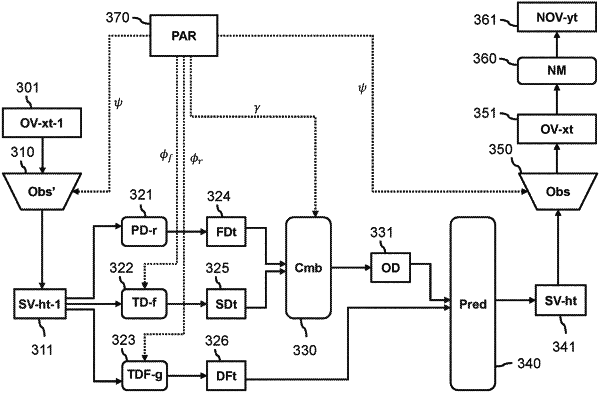| CPC G06N 3/08 (2013.01) [G05B 13/027 (2013.01); G05B 13/048 (2013.01); G06N 3/047 (2023.01)] | 20 Claims |

|
1. A computer-implemented method for generating and using a model of a computer-controlled system with which the computer-controlled system predicts states of the computer-controlled system for operation of the computer-controlled system, the prediction being performed by applying sensor measurements of the computer-controlled system to the trained model, the method comprising
accessing, by at least one processor, model data defining a model that uses a stochastic differential equation (SDE) that includes a set of variables having a drift component and a diffusion component, wherein the drift component includes a predefined part whose parameters are fixed and a trainable part whose parameters are adjustable by a training;
using, by the at least one processor, at least one sensor of a computer-controlled system to obtain a set of observations of the computer-controlled system, each observation of the set of observations including a time series of measurements of physical quantities of the computer-controlled system and/or an environment of the computer-controlled system obtained using the at least one sensor;
training, by the at least one processor, the model based on the set of observations, the training the model including iteratively performing the following until obtainments of a final version of the adjustable parameters of the trainable part of the drift component:
using the model to make a time-series prediction of a state of the computer-controlled system, at a current time point based on values of the set of variables of the SDE that represent the measurements of the physical quantities at a previous time point, wherein the making of the prediction includes:
evaluating the predefined part of the drift component to obtain a first drift;
evaluating the trainable part of the drift component to obtain a second drift;
combining the first drift and the second drift to obtain an overall drift; and
identifying, as the predicted state, a state corresponding to the overall drift with a stochasticity characterized by the diffusion component;
deriving a training signal by comparing the time-series prediction to an observation of the set of observations; and
adjusting at least the parameters of the trainable part of the drift component based on the training signal to optimize a contribution of the trainable part of the drift component to the overall drift; and
during the operation of the computer-controlled system, a processor of the computer-controlled system:
continually obtaining, by a processor of the computer-controlled system and from the at least one sensor of the computer-controlled system, the sensor measurements, the sensor measurements being of the physical quantities; and
predicting, by the processor of the computer-controlled system, a current state of the computer-controlled system by applying to the model, and from the continually obtained measurements, one or more of the obtained measurements of an earlier time.
|